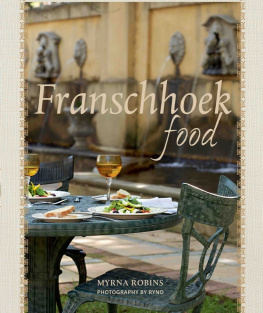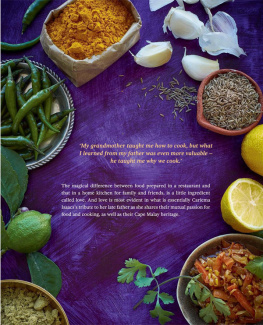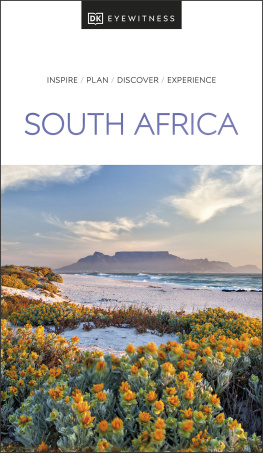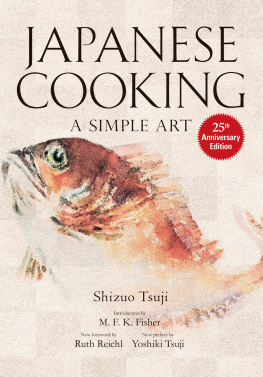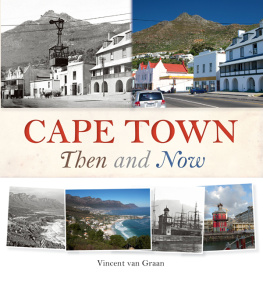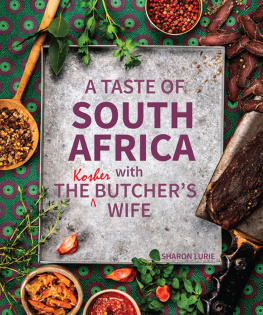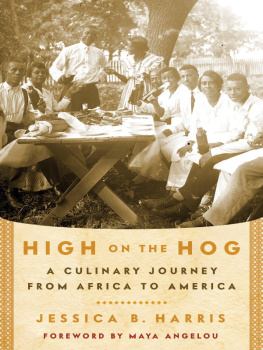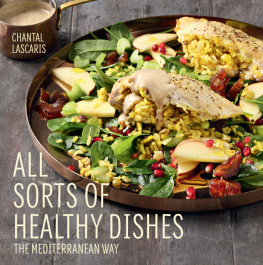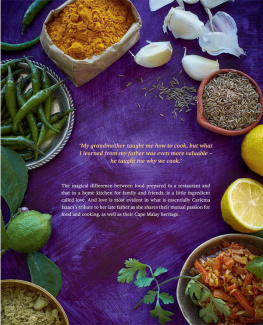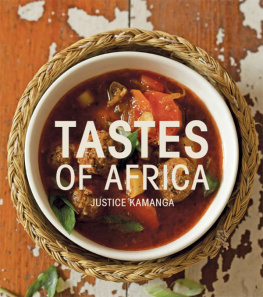
ACKNOWLEDGEMENTS
By its very nature, a book such as Franschhoek Food includes input from many people. My grateful thanks go, first of all, to the Struik Lifestyle team: to publisher Linda de Villiers, who got the project off the ground and perfected the result, to managing editor Cecilia Barfield, who, as my editor, was such a pleasure to work with, and talented senior designer Bev Dodd whose enthusiasm never faltered as her stunning ideas took shape. Rynos images of people and places, along with his irresistible food shots are self-evident proof of his huge contribution.
I am indebted to archaeologist Dr Janette Deacon who was generous with her research, to historian Tracey Randle of Solms-Delta estate for her help with sourcing old photographs, and to Franschhoek Wine Valley manager Siegfried Schfer for early pictures of the valley. Juna Malherbe, geneaologist at the Huguenot Memorial Museum, provided invaluable information and former Wine Valley officer Felicity Rennie answered queries efficiently and promptly.
Finally, my thanks go to Ann Ferreira whose guest suite and hospitality were greatly appreciated; to Topsi Venter, always ready with refreshment in all seasons; and, last but by no means least, to Vern for his ongoing support.
MYRNA ROBINS
This ebook published in 2013 by Struik Lifestyle
(an imprint of Random House Struik (Pty) Ltd)
Company Reg. No. 1966/003153/07
Wembley Square, Solan Road, Cape Town 8001
PO Box 1144, Cape Town, 8000, South Africa
Copyright in published edition: Random House Struik (Pty) Ltd 2009, 2012
Copyright in text: Myrna Robins 2009, 2012
Copyright in photographs: Random House Struik (Pty) Ltd 2009, 2012
excluding
(The Huguenot Memorial Museum); (bottom right Mont Rochelle Hotel and Mountain Vineyards)
All rights reserved. No part of this publication may be reproduced, stored in a retrieval system or transmitted, in any form or by any means, electronic, mechanical, photocopying, recording or otherwise, without the prior written permission of the publishers and the copyright holders.
PUBLISHER: Linda de Villiers
EDITOR: Cecilia Barfield
DESIGNER: Bev Dodd
PHOTOGRAPHER: Ryno
PROOFREADER AND INDEXER: Joy Clack
ePub ISBN 978-1-43230-177-4
PDF ISBN 978-1-43230-178-1
Print ISBN 978-1-77007-737-9
Get monthly updates and news by subscribing to our newsletter at www.randomstruik.co.za
Contents

Foreword
It was 25 years ago that Adr and I arrived in Franschhoek. It was winter. It was raining. The town was deserted. There were no parked cars only a tractor and its trailer stood outside Michael Trulls 1688 Winehouse and Restaurant.
We fell in love then with the village, nestled in the most beautiful wine valley in the world a love affair that has never diminished.
We bought the Winehouse and renamed it Le Quartier Franais, and shortly thereafter, Carol Dendy Young opened La Petite Ferme, overlooking the blue mountains and the oh, so very green valley. That was the beginning. After Adr died, Le Quartier Franais was sold to Susan Huxter, who has done so much to further develop the Franschhoek village as a gourmet destination.
The first years were difficult. One had to fetch fresh fish from Hermanus, mushrooms and lettuce from Stellenbosch, real coffee from Paarl and fresh yeast from Cape Town.
One waited for clients who never came.
But it was worth it. The love infused into the cooking eventually started to draw diners from Cape Town, and today they come from all four corners of the globe. As the diners came, other great restaurateurs settled in the village.
Today, Franschhoek, with so many outstanding restaurants concentrated in the small village, has become known as the food and wine capital of the Cape. Even in the depths of winter, the village is busy. Outside the restaurants, dozens of cars are parked as happy diners enjoy some of the best wines and food available anywhere in the world.
It has been a miracle.
Myrna Robins has travelled this journey of those last 25 years, too. There is no one better able to tell the story of that miracle than she.
ARTHUR MCWILLIAM SMITH
FRANSCHHOEK, FEBRUARY 2009
Introduction

By the late 19th century, although sparsely populated, the village was nearly self-sufficient.
Visitors to Franschhoek will find a bountiful combination of diverse cuisine, fine wine, warm hospitality and professional service, served up in one of the most beautiful valleys in all the world. A patchwork of vineyards and orchards surrounds this Boland village, all embraced by the towering peaks of the Wemmershoek, Groot Drakenstein and Franschhoek mountain ranges, which form a series of majestic backdrops at every compass point.
GETTING THERE
Whether you approach Franschhoek from the north off the N1 motorway, or via the N2 and Stellenbosch from the south-west, you will reach the R45 at Simondium several kilometres from the village. Once across the Berg River you pass farms with impressive entrances adorned with Gallic names that perpetuate the birthplace of their founders. Several of the magnificent gabled farmsteads, which can be glimpsed through the trees, reflect the flowering of Cape Dutch colonial architecture at the tip of Africa. But by far the most spectacular route to the village is via the Franschhoek Pass that snakes over the mountain from the R43 near Villiersdorp in the Overberg.
For more than a year I travelled this route to and from Franschhoek while gathering material for this book, seeing the pass in every season, marvelling at the changes in colour, vegetation and mood as the fynbos bloomed, then died back, as the peaks glittered in the summer sun, were clothed in autumn mist, or powdered with late winter snow.
No matter what the weather, as I reached the summit after negotiating the series of corkscrew bends, I always paused to gaze at the valley below me, stretching north between its sheltering mountains. This panorama must surely rate as one of the best in Africa, viewed from one of our finest passes. For the Franschhoek Pass, built in 1825, is not only the first engineered pass in South Africa, but also an impressive mountain road that features on its eastern side the oldest bridge in use in the country, known as Jan Jouberts Gat, and a national monument.
Another mode of transport increasingly favoured by international travellers is a helicopter ride to Franschhoek, landing at helipads at restaurants, hotels and wine estates in the valley. Having experienced this trip from Cape Towns V&A Waterfront to Haute Cabrire at the foot of the Franschhoek Pass, I can testify that it is both thrilling and awe-inspiring, leaving passengers with treasured memories of a series of unfolding scenes of rare beauty.
THE FIRST INHABITANTS
The Franschhoek valley has been inhabited for at least a million years. Hand axes and cleavers uncovered by workers planting vines in the gravel terraces above the river suggest the existence of Early and Middle Stone Age people.
During the last 25 000 years, the population of the San increased in the valley, reports Dr Janette Deacon, a renowned South African archaeologist specialising in the Later Stone Age and rock art of the country. Not only did they leave rock paintings in the Franschhoek mountains, but also plenty of tools, bows and arrows, and ostrich eggshell beads as evidence. A good collection of their stone tools is exhibited at the museum at Solms-Delta wine estate near Simondium. These hunter-gatherers enjoyed feasts of venison finding steenbok, grysbok and bushbuck in the region. They also ate tortoises, dassies (hyrax), locusts and termites, and, just occasionally, larger antelope such as eland, along with zebra and buffalo. They collected honey from hives, and fish and freshwater mussels from the rivers. Ventures to the coast yielded seafood, which was dried and brought home.

